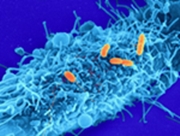Zooming in on bacterial weapons in 3D
03 Sep 2012
The plague, bacterial dysentery, and cholera have one thing in common: These dangerous diseases are caused by bacteria which infect their host using a sophisticated injection apparatus.
 Through needle-like structures, they release molecular agents into their host cell, thereby evading the immune response. Researchers at the Max Planck Institute for Biophysical Chemistry in Göttingen in cooperation with colleagues at the Max Planck Institute for Infection Biology in Berlin and the University of Washington in Seattle (USA) have now elucidated the structure of such a needle at atomic resolution. Their findings might contribute to drug tailoring and the development of strategies which specifically prevent the infection process.
Through needle-like structures, they release molecular agents into their host cell, thereby evading the immune response. Researchers at the Max Planck Institute for Biophysical Chemistry in Göttingen in cooperation with colleagues at the Max Planck Institute for Infection Biology in Berlin and the University of Washington in Seattle (USA) have now elucidated the structure of such a needle at atomic resolution. Their findings might contribute to drug tailoring and the development of strategies which specifically prevent the infection process.
Hundreds of tiny hollow needles sticking out of the bacterial membrane - it is a treacherous tool that makes pathogens causing plague or cholera so dangerous. Together with a base, embedded in the membrane, these miniature syringes constitute the so-called type III secretion system - an injection apparatus through which the pathogens introduce molecular agents into their host cell.
There, these substances manipulate essential metabolic processes and disable the immune defence of the infected cells. The consequences are fatal as the pathogens can now spread within the organism without hindrance. To date, traditional antibiotics are prescribed to fight the infection. However, as some bacterial strains succeed in developing resistances, researchers worldwide seek to discover more specific drugs.
The exact structure of the 60 to 80 nanometre (60 to 80 millionths of a millimetre) long and about eight nanometre wide needles has so far been unknown. Classical methods such as X-ray crystallography or electron microscopy failed or yielded wrong model structures. Not crystallisable and insoluble, the needle resisted all attempts to decode its atomic structure.
Therefore Adam Lange and Stefan Becker at the Max Planck Institute for Biophysical Chemistry together with a team of physicists, biologists and chemists chose a completely novel approach. In cooperation with David Baker at the University of Washington, and Michael Kolbe at the Max Planck Institute for Infection Biology, the scientists successfully combined the production of the needle in the laboratory with solid-state NMR spectroscopy, electron microscopy, and computer modelling.













.jpg)






.jpg)









